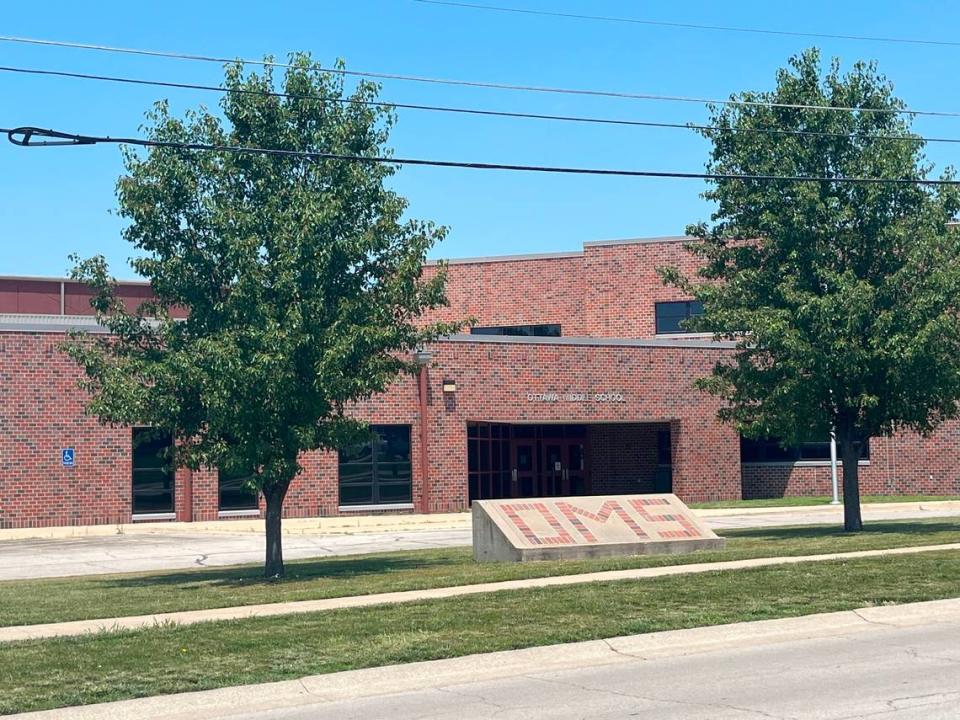Kansas boy dealing with bullying, racism brought knife to school. Now he faces a felony
He was called the n-word.
He was turned away from a table of white students.
He was told to “go back to picking cotton.”
But after reporting these acts of racism to school officials in the rural town of Ottawa, Kansas, the mother of the 12-year-old bi-racial boy being targeted said her son didn’t trust adults at the school to protect him from his bullies.
In fact, the mom said since the family moved to Ottawa in 2019, he’d dealt with repeated acts of racism and bullying. The Star is withholding their names for their safety.
Time after time, his mother said she told school officials to address the issues, but nothing ever changed. The boy refused to get out of bed most mornings. He feared going to school.
Verbal harassment and racist comments escalated to threats.
This past December, a bully told him to stop coming to school, knocked him to the ground and said if he returned, it would only get worse. His mom alerted school officials, but again she said they took no action. Her son stayed home for days.
Eventually, his parents pushed him to return. They were told otherwise they would be charged with truancy.
Without their knowledge, the boy took a butterfly knife to school. He later said he only planned to use it if the bullies attacked him again.
Now, he’s the one accused of a crime.
Criminal threat charge
This week, the boy had to appear in court for a criminal threat charge that would be considered a level-9 felony if committed by an adult, according to Franklin County court documents.
Court documents allege the boy made a violent threat. His mother and lawyer argued at a bench trial on Monday that he only said he’d use the knife, which had a blade about 1.5 inches long, to protect himself if someone attacked him.
If the boy is removed from the home, the state called for a child support order against his mother.
Vincent Rivera, the boy’s attorney, alleged that a bully told him to “stop coming to school” or “I am going to hurt you” before punching him and knocking him to the ground.
“If you keep coming to school, it’s going to get worse,” the bully allegedly said before walking away with others, according to court documents.
At the trial, a 13-year-old female and 13-year-old male witness testified that the boy fidgeted with the knife in their first period math class. The boy allegedly later displayed the blade and told the witnesses that he would use it if the bully attacked him again, they said.
One of the witnesses reported the knife to a school official, and both of them talked with school officials and police. When his mother arrived at the school to pick her daughter up for an appointment, school officials told her about the incident. She searched and found the knife in the front pocket of his hoodie, and he was sent home.
Rivera argued that Kansas law allows individuals to use force in self defense if there is a legitimate threat. He said because the boy experienced a pattern of bullying that worsened for years, didn’t feel adults at the school made meaningful strides to help him and was forced to return to classes with the bully, he felt he needed to protect himself from the threat.
“He feels like he’s being punished for trying to defend himself,” the boy’s mother said.
Ottawa USD 290 did not respond to multiple requests for comment.

A history of bullying
Since the family moved to Ottawa from Lexington, Oklahoma in 2019 to be closer to her husband’s relatives, the boy’s mom said both of her sons — who are Black and Native American — have dealt with bullying.
Since elementary school, she said her younger son was bullied both at the school and on the bus. She said she went to the school nearly every day to ask school officials why the issues were allowed to continue.
When her younger son moved on to Ottawa Middle School, she said the issues worsened.
At one point, the mother said her son had tried for months to grow out his hair to style it a different way. Other students tugged on his hair and called him a “dirty n-word,” his mother said. He shaved his head when he got home that day.
The boy said school officials identified the students involved using security camera footage. As far as he knows, none of them were punished or stopped. He said it made him feel the school favors white students and wouldn’t listen to his concerns.
His mother reported the incident to administrators and the school board. Officials told her they’d take care of it, but she never heard another word about it, she said.
This past school year, the mom said students bullied her son at games and practices until he left the football team. Another time, students told him he couldn’t sit at a table because of his skin color. A different time, a student told her son he didn’t belong at their school and that he “should go back to picking cotton.”
Each time, she said she reported the incidents to school officials, but the bullying continued.
The school, she said, gave her son a pass allowing him to leave class and go to the office when he felt upset. At one point, there was also a room with a beanbag chair where he could go to decompress.
It helped her son to get away from the bullies, she said, but as far as she knew no disciplinary action was taken to stop the other students from harming her son. Instead, her son consistently missed out on instructional time.
Another student later told her son that “no one likes Black kids here at our school.” That same student, she said, was the person who hit her son and told him that it would be worse if he returned to school.
After that, the boy stayed home for days and feared returning to school. In a meeting to get him to go back, the mom and her son told the principal and a guidance counselor about the incident and that her son was scared to go to class because adults at the school hadn’t helped him before, she said.
When she could get him to go to school, the mom said every morning was a struggle because he worried the bullying would continue with no help from the adults around him. Sometimes she said she bribed him with ice cream or texted him inspirational messages throughout the day to get him to go to and stay at school.
Her older son, who is now in high school, dealt with similar patterns of racist bullying at the middle school, their mother said. At one point, she said the bullying moved to a side street near the school, where someone hit her son with a piece of wood. Police were called but no one was charged, she said.
School administrators didn’t get involved, she said, because the incident happened off school property.
Another time, she said students threw papers with the n-word on them at her older son’s head. The teacher dismissed the situation and the paper was thrown in the trash, the mother said.
When they lived in Oklahoma, the mother said school officials handled bullying incidents directly. Her youngest son was bullied in his Oklahoma elementary school, but she attended a few meetings with school officials before students were suspended and her son no longer had issues.
Because of the constant bullying incidents and the court case in Ottawa, the mother said she left her 9-to-5 job so she could more easily meet with school officials. She instead took a job working early shifts from 3 a.m. to 9 a.m. with UPS to be available to handle issues at the school.
School officials also pulled her older daughter out of class several times a week for around 20 to 30 minutes a day to talk with her younger brother and convince him to go back to class, she said. Even though teachers had instructions to help the boy in his 504 plan, she said the school often asked his mother and sister to instead be the ones to help him.
At the trial, Ottawa Middle School principal Shannon Fanning said she only received one report of bullying toward the boy: the alleged incident from the week prior when another student knocked him down, but she said the school hadn’t found proof of the incident. Other incidents, which Fanning referred to as “disagreements,” had been handled by a school counselor or others at the school, she said.
The 13-year-old male who allegedly hit the boy denied the incident in court and said he had never been in trouble for bullying or suspended by the school for bullying.

‘It should be homey to everyone’
Ottawa, a town of nearly 12,600 people about an hour southwest of Kansas City, looks much like many smaller midwestern towns. Most of the town’s businesses, including restaurants, doctor’s offices, gas stations and pharmacies, run along or near its Main Street.
One stretch of the road features local fares both new and old, from a 6-year-old CBD shop to the more than 115-year-old Plaza Cinema, which holds a world record as the oldest purpose-built movie theater in operation. The rest of the street is home to every fast food stop a college student could want — Subway, Wendy’s, Sonic, Arby’s and on.
But despite its welcoming appearance, the mother and her son said their family’s experiences with racism in Ottawa haven’t been limited to the school. It’s also been an issue they’ve encountered elsewhere in town; an area of Kansas that is almost 90% white.
Around Ottawa, passersby have called her kids the n-word, and she never lets them leave the house without family or friends to help protect them. When they’re gone, she tracks their phones, fearing something could happen.
When they need food or a fun night out, the family never goes into town, they said.
Shopping in Ottawa is reserved for emergencies or quick trips. Otherwise, they find clothes and food in Olathe and go bowling or host family gatherings and birthday parties in Lawrence.
“If I try to go out, then I’m usually scared about racist stuff,” the boy said. “So, I usually just stay in my room.”
Several other parents told The Star their children have also dealt with bullying and racism in the district; charges which led to no changes when they reported the incidents to school officials.
One mother said her son, who is disabled and Hispanic, received fewer disability services than other students who had less need. Multiple parents said white kids at the school haven’t been punished for calling other students the n-word, and counselors in some cases told parents it was OK, because the students hadn’t used the “hard R.”
“There’s a lot of country boys and rednecks around here, and there aren’t a lot of Black people,” said one Ottawa parent whose stepdaughters have dealt with racism from students, teachers and community members. One of his kids commutes to school in Olathe so that she can be around more Black people.
“I think that’s one of the biggest issues with this town,” he said. “Because there’s not a lot of Black people here, they think they can just run them over.”
Growing up in Ottawa, Mykenna Hadl said it was a typical small town, where she knew everyone in school and greeted her neighbors walking down the street. Hadl went to public schools in Ottawa, graduated from Ottawa University and now works in the admissions department at her college alma mater.
The town and college used to feel like separate entities, but now she said community members and business owners welcome the students. Along Main Street, local businesses display signs supporting the school and its athletics. Community members have hosted team dinners, and students shop at stores in town and work there too, she said.
Cathy Sutton taught at Ottawa High School for 13 years starting in the ‘80s and has lived in the town ever since. The school didn’t have much diversity, she said. Every grade had just a handful of Black students, but she never heard reports of bullying or racism directed at them.
Sutton and Hadl each assumed the area leaned heavily right politically until Kansans voted on an amendment that, if passed, would’ve allowed for further restrictions on abortions in the state. Based on lawn signs in residents’ yards, the city seemed more politically divided than they thought.
Hadl and Sutton said they were surprised to hear a student alleged they faced racist bullying within the Ottawa school system for years without action from officials. They acknowledged that, as white women, they may not see or understand the extent to which racism affects their area.
“I hope the community continues to grow in a way more people from the metro could move here and feel welcome,” Hadl said. “Being a small town, it should be homey to everyone, and if it’s not we’re doing something wrong.”
‘Of course he’s the one in trouble.’
Nicole Price, who owns a leadership company and teaches diversity and inclusion, said she’s worked with suburban and rural school districts similar to Ottawa where Black and brown students are ostracized by their white peers.
In spaces where almost everyone is white, Price said, it’s nearly impossible for Black and brown children to escape bullying and racism.
When Black people in any industry try to fight back against discrimination and abuse, she said authorities all too frequesntly take action to stop their complaints rather than the bullying, as they did by charging the 12-year-old.
“Of course he’s the one in trouble,” Price said. “I throw a rock, you throw a rock back and now you’re the one in trouble.”
School district officials across the country attend bullying seminars throughout their career and should have clear ways to intervene to stop the issues from happening, she said. Because white children were bullying a Black student, Price said she wouldn’t be surprised to learn officials turned the other way instead of addressing the problem.
“If that would’ve been the reverse there’s no way this would’ve gone on for four years,” she said.
The microaggressions and outright racism students of color face growing up in majority-white spaces make it nearly impossible to leave “with their souls intact,” Price said.
She said it will take a long time to change the makeup of education to include more educators and administrators of color. In the short term, she said more educators need to be “culturally responsive,” and have empathy for students of color who face bullying and use it to create change.

‘A complete difference’
As the bullying worsened at school, so did the 12-year-old boy’s mental health.
An outside counselor diagnosed him with anxiety and major depressive disorder that they believe was a direct result of the issues he faced at school, his mom said. Medication helped a bit, but her son’s mood didn’t improve much as the bullying continued.
After the December incident, she said her son was suspended for 10 days and started attending an alternative school in the Ottawa school district.
“A couple weeks after being at that school, you could see a complete difference in (my son),” she said. “His attitude towards school, his attitude at home, his responses to getting school work done. Not being scared to go to school.”
After a few months, she said district officials wanted to ease her son back into classes at Ottawa Middle School. She was told that, because her son wasn’t “a troubled kid,” he couldn’t stay at the alternative school.
But after her son returned to even a few classes at the middle school, she saw his attitude revert back. Once again, he refused to get out of bed in the morning and called his mother throughout the day saying he felt unsafe.
The family started searching for other schools for him to attend, but worried that the legal action might prevent him from being accepted. One of the schools asked for a transcript that included details of the bullying incidents, but his mother said when she got the documents from the school, they never provided the full reports.
This month, her son and daughter were accepted at a free boarding school for Native American students in Oklahoma. They’ll attend school more than five hours from home and live on campus.
The school allows students to return home at least once a month for long weekends as well as during holidays, spring break and summers. During meals and extracurriculars, the siblings can spend time together.
“If I could move with him I would,” his mother said. “In a heartbeat.”
While her kids are nervous about adjusting to a new school, their mother said she’s excited for her son to go to classes with more students that look like him.
Her son already picked out electives and extracurriculars, including classes to learn tribal languages, horse training and robotics. As he leaves Ottawa, he’s growing his hair out again and hopes to eventually wear it in braids dyed pink.
On Thursday, the family will drive to Oklahoma for a campus tour. On the way there, they’ll pull over to join a Zoom, where Judge Kevin Kimball will read his decision in the case.
The mother hopes it’s one of the last stops they’ll need to take before her son can move on and start over.
“There’s too much hate in this town,” she said, “and it’s not OK.”

